The Samsung Galaxy Note7 (S820) Review
by Joshua Ho on August 16, 2016 9:00 AM ESTSystem Performance Cont'd
Now that we've covered more general purpose benchmarks that tend to emphasize CPU performance and GPU compute performance, we can look at benchmarks that tend to more strongly emphasize things that games will see benefits from such as improved GPU graphics performance and improved CPU physics processing performance.
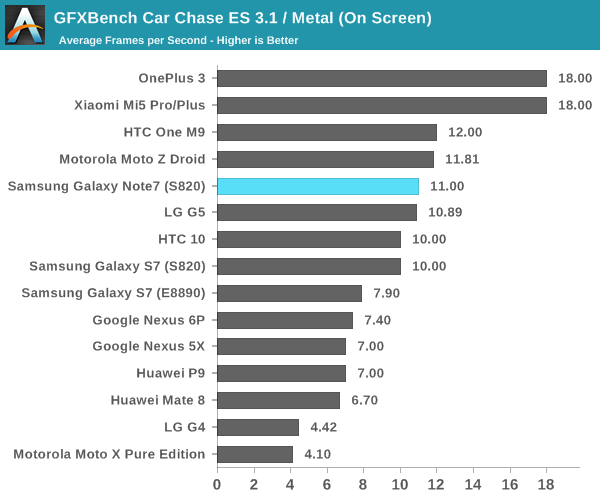
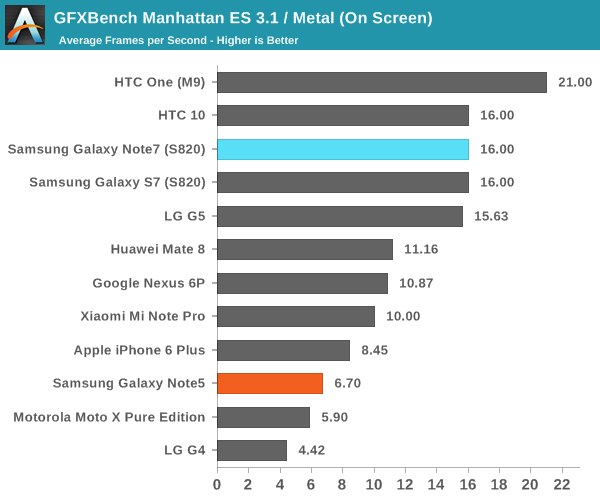
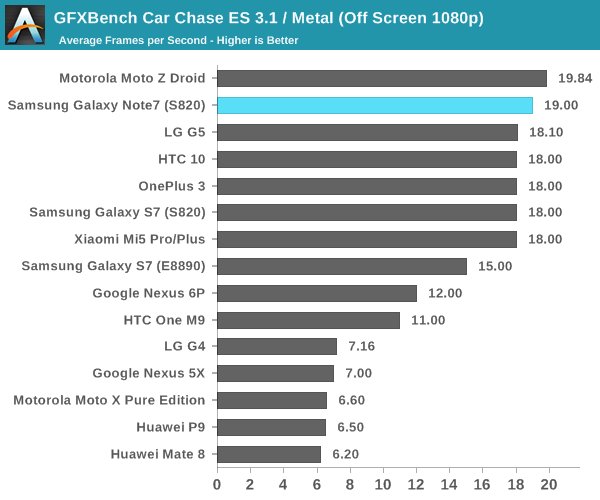
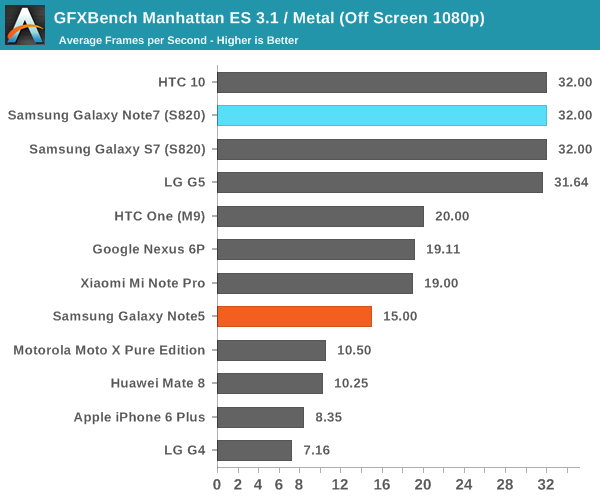

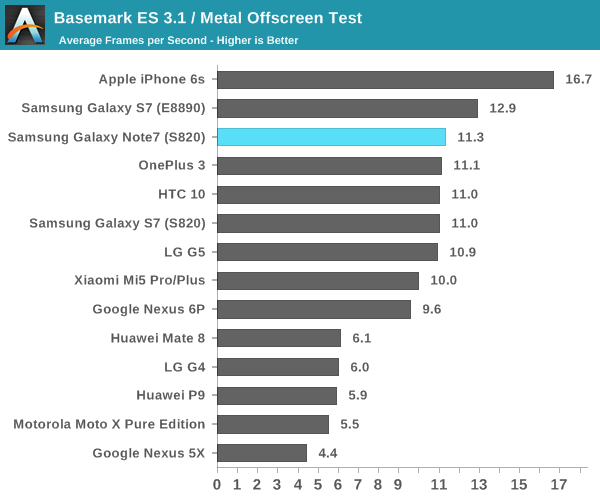
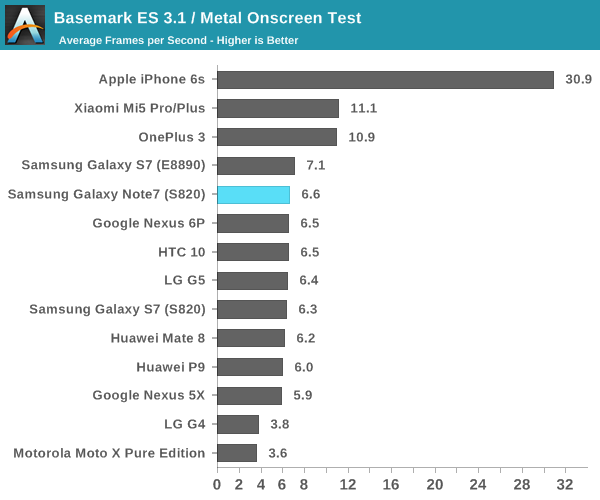
It's probably no surprise, but the Galaxy Note7 performs as expected with the latest drivers and in ideal thermal conditions. The Adreno 530 should be more than sufficient for the forseeable future but for maximum performance it's best to enable 1080p rendering or lower to maximize frame rates in games like Real Racing 3 that tend to really use the GPU to its fullest extent.
NAND Performance
Of course, while Discomark provides a sort of holistic view of performance for a specific task, it’s also important to at least try and break down the various aspects that impact system performance so rather than simple black box testing we can further understand what factors influence performance and therefore provide additional information to make better buying decisions. One of the major contributors to general purpose performance is going to be storage performance, which is often something often ignored by marketing as the nitty gritty details of NAND storage realistically require some background in solid state physics and devices to understand, as well as some understanding of computer science and engineering.
While I’m not really happy with the state of our mobile storage benchmarks, for now I don’t really see another option here as the publicly available storage benchmarks for Android and iOS are fairly basic. Putting aside the state of the benchmarking industry, our current benchmark remains AndroBench 4 which provides at least some basic storage benchmarking capabilities. We use custom settings with this benchmark which attempts to make the test more realistic as the default settings are just wildly unrealistic. This includes adjusting the buffer size, increasing the file size to 100 MB, and only using one thread instead of 8. 256KB file size is targeted as this is the most common block size if you profile this kind of thing for sequential writes and reads, while 4KB block sizes are the most common for other tasks as the vast majority of computer architectures use 4KB pages for virtual memory. Single-threaded I/O is common in most cases because multi-threaded programming is still difficult for most people to reason about in an effective manner because conscious thought is inherently serial in nature with some multiplexing. In addition to this, many eMMC solutions on the market don’t really perform well with multiple threads simultaneously as the controller can’t do anything with extra requests other than reply with a busy signal which already happens with a single thread.
Putting aside discussions of testing we can take a look at the storage solution used in the Galaxy Note7 before getting into the actual results. The Note7 continues to use basically the same storage solution as the Galaxy S7 and S6, which is to say an MLC-based solution that has a UFS Gear 3 single lane interface for bandwidth up to 600 MB/s and basically has the exact same model number if you check the SCSI devices attached to the system save for some changes that indicate the higher 64GB storage relative to the 32GB chips that are most common in the Galaxy S7.
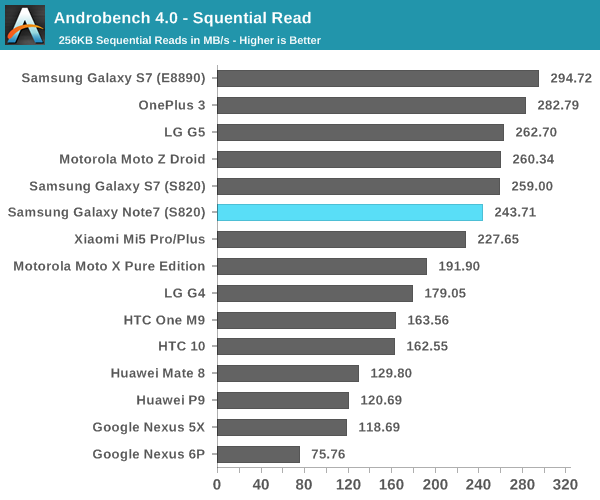

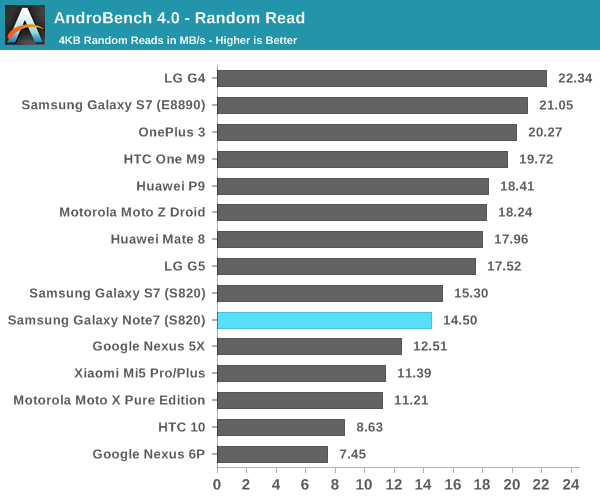
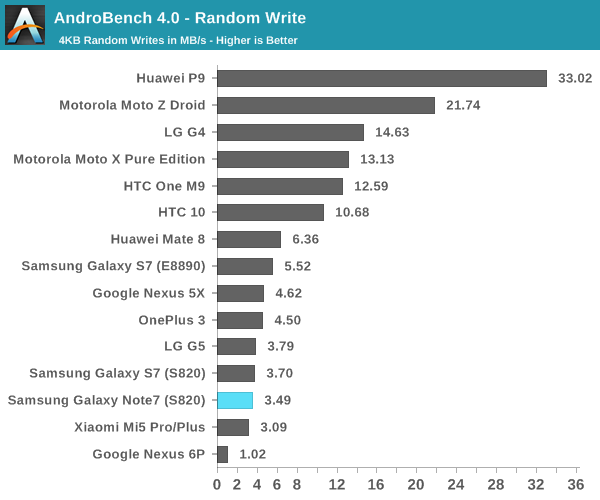
Looking at the test results it performs exactly as quickly as you’d expect from this MLC solution as we’ve tested it in the Galaxy S6, S6 edge, S6 edge+, Note5, S7, S7 edge, and now the Note7 as well as the LG G5. The performance here is acceptable but obviously if you look at burst performance the iPhone 6s has a faster solution due to the hybrid SLC/TLC storage solution. The main benefit of pure MLC NAND is that performance is more consistent as there’s no precipitous drop when the SLC buffer fills. There’s always room to improve but I don’t really see how it’s going to happen unless Samsung moves to V-NAND for the next generation.










202 Comments
View All Comments
theduckofdeath - Wednesday, August 17, 2016 - link
A person who so clearly starts out with a negative stance about everything he is reviewing, just because it concerns the mammoth competitor to the fruity toy company he so clearly loves, really can't make a good review. A written review is literally all about the language in it.Yeah, I agree that the verge is worse. Then again, that's why I completely stopped reading anything there a long time ago. Being almost as bad as the worst, is that really a good thing?
osxandwindows - Wednesday, August 17, 2016 - link
Then go and make your own review and stop complaining.mjh483 - Tuesday, August 16, 2016 - link
I really agree with your opinion about the camera because I've always felt that Galaxy smartphones produce very unnatural images and videos. The post processing is awful.However, don't you guys feel that your reviews about Samsung smartphones have a pessimistic and bored tone whereas Apple product reviews are full of words like "impressive" and "incredible"? You have to give credit where it's due.
grayson_carr - Tuesday, August 16, 2016 - link
Maybe they sound bored because this devices is boring. There is very little new stuff compared to the 6 month old S7 Edge. I'm sure if Apple released the iPhone 6S six months before the iPhone 6S Plus, Anandtech would sound pretty bored in the 6S Plus review as well because it would be 95% the same devices, but with a larger screen and one or two extra features.jiffylube1024 - Tuesday, August 16, 2016 - link
You're going to use that argument? The iPhone 6S is basically a 6 with a faster SoC, different camera (improved video, same still quality) and the semi-useless 3D touch. They had a YEAR to iterate that one...OK it's a bigger jump than the S7 Edge to Note 7. The Note 7 basically is an S7 Edge (do they really need all 3 at this point? I guess you get to choose between the S-Pen vs. bigger battery).
Still, the S7 Edge was a really well executed device.
mjh483 - Tuesday, August 16, 2016 - link
How is this a bigger jump? There's no performance improvement here, which means the core user experience is still the same. iPhone 6s provides a palpably faster experience in every aspect over the 6. That alone is a big difference.CloudWiz - Tuesday, August 16, 2016 - link
And the S7 was just the S6 with a faster SoC, better camera, and semi-useless features like water resistance and microSD. The Note 7 is the same relative to the Note 5.(Seriously, how often do you drop your phone in water? And personally, I would never choose to willingly slow down my phone by adding crappy microSD storage into it.) How is this phone any different.SirCanealot - Wednesday, August 17, 2016 - link
Actually, my girlfriend rocked a Galaxy S Mini 5 for a little while (bit of a dog obviously though, so we changed it for something better) and was washing her hands in the sink. Phone slipped into the sink into the running water. She shat herself for about 5 seconds before releasing it was waterproof :)And adding a micro SD card to your phone does not slow it down*; please stop spreading misinformation.
*Unless of course you start moving apps to it maybe.
lilmoe - Thursday, August 18, 2016 - link
"semi-useless features like water resistance and microSD"lol. Semi-useless? Really?
techcrazy - Tuesday, August 16, 2016 - link
Great review. Thanks for the all the hard work.